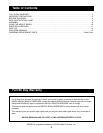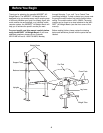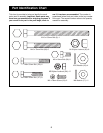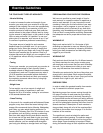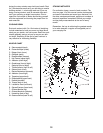
11
THE FOUR BASIC TYPES OF WORKOUTS
• Muscle Building
In order to increase the size and strength of your
muscles, you must push your muscles to a high per-
centage of their capacity. You must also progressively
increase the intensity of your exercise so that your
muscles continue to adapt and grow. Each exercise
can be tailored to the proper intensity level by chang-
ing the amount of weight used, or the number of repe-
titions or sets performed. (A “repetition” is one com-
plete cycle of an exercise, such as one sit-up. A “set”
is a series of repetitions performed consecutively.)
The proper amount of weight for each exercise
depends upon the individual user. It is up to you to
gauge your limits. Select the amount of weight that
you think is right for you. Begin with 3 sets of 8 repeti-
tions for each exercise that you perform. Rest for 3
minutes after each set. When you can complete 3 sets
of 12 repetitions without difficulty, increase the amount
of weight.
• Toning
To tone your muscles, you must push your muscles to
a moderate percentage of their capacity. Select a
moderate amount of weight and increase the number
of repetitions in each set. Complete as many sets of
15 to 20 repetitions as possible without discomfort.
Rest for 1 minute after each set. Work your muscles
by completing more sets rather than by using high
amounts of weight.
• Weight Loss
To lose weight, use a low amount of weight and
increase the number of repetitions in each set.
Exercise for 20 to 30 minutes, resting for a maximum
of 30 seconds between sets.
• Cross Training
In the pursuit of a complete and well-balanced fitness
program, many have found that cross training is the
answer. We recommend that on Monday, Wednesday
and Friday, you plan weight training workouts. On
Tuesday and Thursday, plan 20 to 30 minutes of aero-
bic exercise, such as cycling, running or swimming.
Rest from both weight training and aerobic exercise
for at least one full day each week to give your body
time to regenerate. By combining weight training with
aerobic exercise, you can reshape and strengthen
your body, plus develop a stronger heart and lungs.
PERSONALIZING YOUR EXERCISE PROGRAM
We have not specified an exact length of time for
each workout, or a specific number of repetitions or
sets for each exercise. It is very important to avoid
overdoing it during the first few months of your exer-
cise program, and to progress at your own pace. If
you experience pain or dizziness at any time while
exercising, stop immediately and begin to cool down.
Find out what is wrong before continuing. Remember
that adequate rest and a proper diet are also impor-
tant.
WARMING UP
Begin each workout with 5 to 10 minutes of light
stretching and exercise to warm up. Warming up pre-
pares your body for exercise by increasing circulation,
raising your body temperature and delivering more
oxygen to your muscles.
WORKING OUT
Each workout should include 6 to 10 different exercis-
es. Select exercises for every major muscle group,
with emphasis on the areas that you want to develop
the most. To give balance and variety to your work-
outs, vary the exercises from workout to workout.
Schedule your workouts for the time of day when your
energy level is the highest. Each workout should be
followed by at least one day of rest. Once you find the
schedule that is right for you, stick with it.
EXERCISE FORM
In order to obtain the greatest benefits from exercis-
ing, it is essential to maintain proper form.
Maintaining proper form means moving through the
full range of motion for each exercise, and moving
only the appropriate parts of the body. Exercising in
an uncontrolled manner will leave you feeling exhaust-
ed. On the exercise poster accompanying this manual,
you will find photographs showing the correct form for
several exercises. A description of each exercise is
also provided, along with a list of the muscles affect-
ed. Refer to the muscle chart on page 12 to find the
locations of the muscles.
The repetitions in each set should be performed
smoothly and without pausing. The exertion stage of
each repetition should last about half as long as the
return stage. Proper breathing is important. Exhale
during the exertion stage of each repetition and inhale
Exercise Guidelines




